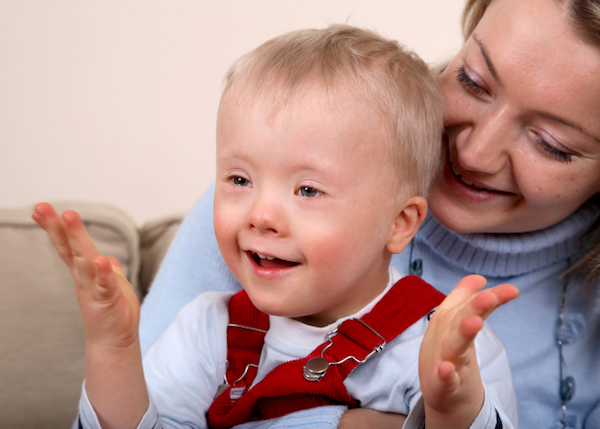We sat down with our founder, Mandy, and clinical supervisor, Chris, to talk about speech and language development in children with Down syndrome (DS), why it’s delayed, and what you can do to support it.
How is language development different for children with Down syndrome?
DS is the most common genetic disorder and the leading cause of intellectual disability, arising as a consequence of a chromosomal abnormality (when an individual has three copies of chromosome 21 instead of two).
Although all children with DS present with individual differences, they tend to share certain language characteristics:
- The majority will learn to use speech as their primary means of communication.
- Babies’ cooing and babbling may only be slightly delayed, while delays in first words and other speech and language milestones are more pronounced.
- Babies and toddlers use gestures to communicate at a comparable rate as typically-developing peers, but they may use them differently.
- Receptive language (understanding) is stronger than expressive language (talking).
- Challenges with articulation (making speech sounds), phonology (discriminating between speech sounds), and syntax (organizing words into sentences) can persist into adulthood.
What causes language delays and challenges in children with Down syndrome?
There are a few main reasons for language delays and challenges:
Structural and functional differences such as:
- Smaller and narrow upper jaw and high palatal arch, which reduces the amount of space for the tongue
- Low muscle tone
- Decreased strength in oral facial muscles
- Weaker immune system leading to an increased incidence of upper respiratory infections
- Heart and respiratory problems
- Gastrointestinal issues (such as acid reflux)
Hearing Difficulties
Children with DS have a higher incidence of or chronic ear disease. This, in turn, interferes with language development because one of the main ways we learn to understand and use language is by listening to others speak. Hearing problems can also interfere with the way that we hear, process and produce sounds. Children with DS have:
- Narrow ear canals leading to increase ear wax and fluid build up
- Increased occurrence of ear infections
- Higher incidence of hearing loss
Cognitive delays
Children with DS learn and process information at a slower rate. Cognitive delays in children with DS range from mild to profound and can impact their:
- Attention span
- Memory (especially verbal)
- Judgment
- Impulse control
- Speech and language development
How can you support language development in a child with Down syndrome?
- First, start early! Enlist the help of professionals who are highly-trained to evaluate and treat babies with DS. In the U.S., look for federally-funded programs like Early Steps.
- Tackle hearing and breathing problems in a timely manner with a qualified doctor.
- Hearing screenings are recommended at birth and then every 3-6 months until the age of 3 and then yearly after age 3.
At home:
- Use a lot of visuals, such as baby sign language, gestures, pictures, and books with one image and one written word per page.
- Read books that are predictable, repetitive, and rhythmic (Dr Seuss, Brown Bear Brown Bear, Llama, Llama red pajama).
- Emphasize daily routines, during which you do the same things in the same order and use gestural and verbal language to narrate your actions.
- Nursery rhymes, singing, and finger play are important for speech, language, and hearing development.
Above all, connect. Enthusiasm for connecting with others is a strength of children with DS. Connection through cuddling, eye contact, back and forth communication (using facial expressions, gestures, and words), and play all lay the foundation for children to reach their full potential – in language and every other area of development.


Recent Comments